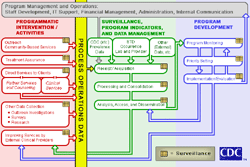Business Process Management Model (BPMM)
The Business Process Management Model (BPMM) project was an initiative conducted by the Division of STD Prevention (DSTDP) in collaboration with state and local health departments to define a leading practice Business Process Management Model for STD prevention. This initiative seeks to improve and augment STD prevention practices, and inform the development of the STD Program Area Module (STD PAM), as part of the National Electronic Disease Surveillance System (NEDSS). The goal of the initiative is to document the vision for STD Prevention programs, map out required changes for implementation, and translate the vision for the technology developers building integrated surveillance and response systems to support STD Programs.
Kick Off
Overview – A very brief descriptive overview of the concepts of business process modeling.
Summary – A brief summary of the STD prevention BPMM project and its objectives and outcomes.
Vision - Outlines the vision, objectives and guiding principles for Sexually Transmitted Disease Prevention within CDC-funded project areas.
Current State
Organizational Assessment – Observations of STD Prevention activities within DSTDP and State and Local Health Departments and recommendations offered for immediate positive impact.
Overall Process Model – Outlines the Business Process Management Model for Sexually Transmitted Disease Prevention at state and local health departments at the Mega Process and Major Process level.
Current State Description – Describes current state STD Prevention processes identified within grantee organizations, categorized through the business processes model identified above. Also describes current state of organizational design, culture, external partners, technology support and political considerations within grantee organizations.
Current State Flows – Graphical representations of current STD Prevention process flows.
Future State
Literature Review – Examines leading practices in related initiatives in business process modeling, collaborative technology development and process improvements related to technology implementations.
Leading Practices Summary – A summary of how state and local STD prevention programs will conduct prevention activities in the future. Includes gap analysis of current state vs. future state.
Leading Practices Detail – A detailed description of how state and local STD prevention programs will conduct prevention activities in the future. Includes gap analysis of current state vs. future state.
Future State Flows – Graphical representations of future STD Prevention process flows.
Change Management – Discusses change management considerations for STD Prevention departments within CDC funded grantee organizations as they adopt leading practices and integrated disease surveillance and investigation applications.
- Page last reviewed: June 27, 2013
- Page last updated: August 27, 2007
- Content source:


 ShareCompartir
ShareCompartir
